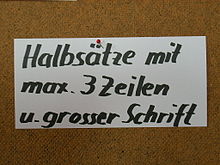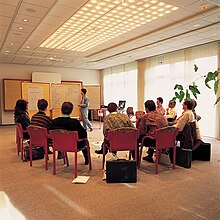Notice board moderation
The METAPLAN is a facilitation method for working with groups. Ideas are produced, collected, classified, evaluated and decided in the team. The core of the method is the visualization visible to all participants on the pin board with text on nodes and drawn edges as a colored graph.
aims
Moderation is a method of controlling communication in work groups. It promotes the motivated, active cooperation of all those involved. The aim is to work together towards a common goal and to achieve a jointly developed result that is understandable for everyone.
- Producing ideas: Creative ideas are written on cards. This card technique is a form of brainwriting (the written form of brainstorming ). The more cards the better, and as in brainstorming, everything is allowed, even “crazy” things. In a variant, the cards are given to the neighbor, who takes them as a suggestion for further or further ideas.
- Collect questions: Questions or problems are collected on a topic. This opens up the greater breadth and depth of the topic from the perspective of all participants.
- Exchanging opinions: Thoughts, opinions and aspects are collected on a question. This makes the perspectives of all participants visible to everyone.
- Developing solutions: Work steps are planned for tasks and responsibilities are defined. Solutions are sought for conflicts (see conflict resolution ).
Methods
theses
The moderation begins with a thesis - or several contradicting theses - from which structuring questions are derived. The thesis describes the topic and possible goals, arouses curiosity and activates. Example: “Biofuel dramatically increases famine” or “Frustration and boredom lead to obesity” or “A secure job increases identification and performance” or “If we continue like this, we are facing ruin”. The theses are often presented by a manager or a representative of a particularly affected group.
Theses are also used in the course of the moderation as an expressive summary of results (example: “In Argentina, maize is scarce as a food”). Or to assess the mood (example: "I am considering switching to biofuel - yes / no").
Card query
Every card query begins with a clear question. Example: "What are the decisive tasks of the teacher?" Or "What are the goals of our school?" Or "What could prevent someone from going on the class trip?" And "What solutions are there for this?"
Carrying out a card query comprises the following steps:
- Explain the question / objective of the query
- Explain method
- Hand out cards and felt-tip pens
- each participant writes their ideas on their cards (e.g. 10 minutes)
- each card is pinned to the wall (stimulating further ideas)
- Arranging and grouping the cards (common understanding of the cards)
Depending on the task, visions are then concretized and translated into goals, problems analyzed, priorities set, processes designed, projects developed, actions planned, appointments agreed.
Interrogation
An alternative to the card query is the call query. As usual, a clear question is asked, and the participants call their answers to a writer, who then writes them down on a card in a half-sentence. The cards are then read out by the moderator and, with the help of the group, pinned to the wall according to topic. This helps with participants with little practice in formulating and writing, but at the same time takes personal responsibility.
Organize and "cluster"
The cards are rearranged accordingly for sorting. The cards are grouped according to topic in "clusters" or columns. The groups are given headings. Additional ideas can be written on cards.
The groups are given headings. Trainer markers with a chisel tip and ergonomic recessed grips and different colors are suitable for legible writing and for surface coloring. Relationships and contexts are shown with so-called moderation markers (also in expressive colors) (lines, arrows, pictograms, images, comics, mind maps , graphics, tables , etc.).
Rate it
Cards can be arranged intuitively (on demand) according to their meaning. Or they are evaluated by “scoring”. For this purpose, each participant receives six adhesive dots, for example, and sticks three dots to his favorite, two to the second most important card and one to the third most important card. After all participants have distributed their points, you can see at a glance which cards are perceived as particularly important. Instead of sticking dots, lines can also be distributed and counted in blocks of five, as in card games.
To do list
Often tasks or projects are derived from the processed topics. A to-do list is then used to record who does what, when, where, with whom and by when. It also serves to document the current processing status.
Final presentation
At the end, all energies of the group are brought together again and what has been achieved and what has been achieved are recognized together and what has not yet been achieved is named. The moderation concludes with an outlook on further developments.
dramaturgy
The dramaturgy decides which atmosphere is created in the room, how lectures, presentations and discussions are combined into a useful whole, which results are possible and in which mood the participants leave the event at the end. Dramaturgy consists of three levels:
- Create a conducive work atmosphere and group culture
- plan and structure an event and open, manage and close it accordingly
- connect the factual and relational level
Moderation is both a craft and an art.
Atmosphere and culture
“Art” means that the moderator creates an atmosphere and culture in which the craft can be used in a targeted manner. Which effects are produced? What images are produced in the minds of the participants? Which energies are awakened? How are these brought together?
To do this, he uses dynamic forms of moderation, creates arcs of tension and involves everyone. He is a host, tamer, leader, godfather, pastor, guide, ignorant (“ I know that I know nothing! ”) And much more. The most important means are asking, active listening , summarizing and structuring. The moderator creates the dramaturgy through words, voice, movements, gestures, changes of position, postures, withdrawal and action.
Planning and structuring
Good moderators plan the course of a moderation in individual steps. The main questions are: Who are the participants? What are your personal concerns, fears and competencies? What does the group or the client want? How much time is available? How much experience does the group have with group work and moderation? What preliminary work has already been done? With what results? How are the power structures? Which conflicts have to be considered?
From this, the moderator then develops a concept for the process, determines the theses and questions, determines the methodological steps, and makes a precise schedule for each individual step. If different development paths are possible, these are taken into account by planning a “branched dramaturgy”. After an inviting and startling opening, the moderator implements the individual steps. And with a binding conclusion, he ensures that the group and all participants happily go home with a feeling of "now a new chapter begins".
Factual and relationship level
In every communication, a factual level and a relationship level act at the same time (see four-ears model ). Mutual appreciation, mindfulness, curiosity and the will to create together are prerequisites for success. It is the moderator's task to create an atmosphere in which a corresponding “we” feeling arises.
Interpersonal conflicts must be recognized and, if necessary, dealt with. If interpersonal issues are dealt with at the factual level, the moderation process is disrupted and the result worsened. Hidden motifs also interfere with success (see iceberg model ).
The topic-centered interaction , in which the tension triangle of ego, group and topic is methodically considered and balanced, has proven itself .
technology
material
The pin board is a fixed foam board in the space of 110 cm × 140 cm that can be moved freely and is covered with wrapping paper. The cards have a format of 1/3 DIN A4 (21 cm × 10 cm) and are made of sturdy paper (> 120 g / m²). White recycled paper or pale colors for a good contrast to the black font are suitable. The felt pens have a line thickness of 2 to 3 mm. The cards should be written on three lines in half sentences, with a font size that can be easily read from a distance. The cards are pinned with short pins with a round head. The needles are in a pin cushion that the moderator wears on his wrist.
room
A roughly square room in which all participants can sit in a circle or oval chair has proven to be effective. Everyone should see the other. In one corner there are three or more pin boards, covered on both sides with matt wrapping paper, and 2 flipcharts with unlined paper. On the wall there are magnetic rails with magnets for hanging up ready-made flipcharts and pinboard (can also be done with masking tape). On a trolley or a small table there are felt pens, pins, cards, glue sticks and other material. The room should have daylight, the windows should be openable and with sun protection. For group work, the pin boards are placed on the front or in the corners so that the groups turn their backs and do not disturb each other. Pin boards can also be used as mobile room dividers. A projector with a projection surface is required for the presentation of images and films, and a small music system with CD and line-in or USB is required for music.
A room of 50 to 70 m² is sufficient for groups of up to 20 participants. A microphone is helpful for groups of 50 or more participants. Correspondingly more space is needed for large groups .
documentation
Results are recorded with a camera . The course and interim results can also be documented in this way. Images can be sent by e-mail or printed out as a log and documented in this way. Finally, the cards are glued to the wrapping paper with a glue stick and the whole thing is hung up in the project room for visualization and further use.
advantages
With the moderation of the pin board, all participants are included equally. Thoughts and the common decision-making process are visualized. The method enables systematic and successful work. Jointly developed decisions are better implemented. The method is very flexible. The necessary material is now available in every conference center.
History of origin
The pinboard moderation was developed by the Metaplan company around 1970 and is therefore also known as the "Metaplan method".
Electronic meeting systems
Essential elements of the pin board moderation have been incorporated into electronic meeting systems , which - mostly in connection with a telephone or web conference - enable workshops to be held over the Internet.
See also
literature
- Freimuth, Joachim; Straub, Fritz (ed.) (1996): Democratization of Organizations. Philosophy, origins and perspectives of the Metaplan idea. Wiesbaden: Gabler.
- Freimuth, Joachim; Barth, Thomas (ed.) (2014): Handbook Moderation. Concepts, applications and developments. Göttingen: Hogrefe.
- Klebert, Karin; Schrader, Einhard; Straub, Walter: Moderation method. Shaping the formation of opinions and will in groups that learn and live, work and play together. Hamburg: windmill. 3rd edition, 2006, ISBN 978-3-937444-07-9 .
- Stefan Kühl : Visualized discussion. In: Stefan Kühl; Petra Strodtholz; Andreas Taffertshofer (Ed.): Handbook Methods of Organizational Research. VS Verlag für Sozialwissenschaften, Wiesbaden 2009, pp. 195–215.
- Wohlgemuth, André C. (Ed.) (1993): Moderation in Organizations. Bern: Main.
Footnotes
- ↑ Waldemar Pelz : Leading competently: Communicating effectively, motivating employees. Gabler Verlag, Wiesbaden 2004, ISBN 978-3-409-12556-7 , p. 188.
- ↑ Walter Simon : GABAL's large method case: Basics of communication. GABAL Verlag, Offenbach 2007, ISBN 978-3-89749-434-3 , p. 176.






















